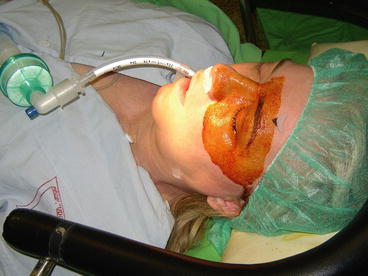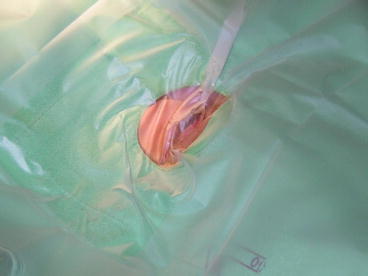(1)
St. Johns, FL, USA
(2)
Helen Keller Foundation for Research and Education, International Society of Ocular Trauma, Birmingham, AL, USA
(3)
Consultant and Vitreoretinal Surgeon, Milos Eye Hospital, Belgrade, Serbia
(4)
Consultant and Vitreoretinal Surgeon, Zagórskiego Eye Hospital, Cracow, Poland
18.1 Disinfection and Draping
Proper disinfection is a crucial element in endophthalmitis prophylaxis in eyes undergoing PPV.
Prior to the operation, the eye and its vicinity should be carefully inspected. Surgery should not proceed if there is discharge or the suspicion of a surface infection.
The skin must thoroughly be cleansed with 10% povidone iodine,1 which must not be wiped off for at least 1 min. The area to be disinfected should be large (see Fig. 18.1).

Fig. 18.1
Preparing the patient for VR surgery. This patient is undergoing surgery in general anesthesia: the nostrils are tamponaded. The side for operation is marked and the skin disinfected with 10% povidone iodine in a large area
The ocular surface must be irrigated with 5% povidone iodine, again left for at least 1 min, and then irrigated with saline/BSS to completely remove the disinfectant solution.
The drape may be placed by the nurse or the surgeon.
Pearl
Typically it is the nurse who drapes the patient. However, in case of an open globe injury, the surgeon should do the draping. Pressure on the globe must be avoided to prevent tissue prolapse or cause an ECH – risks the surgeon appreciates the most.
The skin must be completely dry before the adhesive part of the drape is applied.2
The drape must adhere to the skin “watertight.”
Get Clinical Tree app for offline access
Even if a small opening is present,3 the air can escape as the patient is exhaling. This introduces a potential risk factor for infection from the untreated skin and may cause condensation on the BIOM front lens (see Table 16.5).

Fig. 18.2
The typical error in placing the adhesive drape. There is an opening (no sticking) on the nasal side inferiorly. This is easiest to avoid if the drape is pressed against the side of the nose first, only then onto the rest of the skin
Stay updated, free articles. Join our Telegram channel

Full access? Get Clinical Tree


